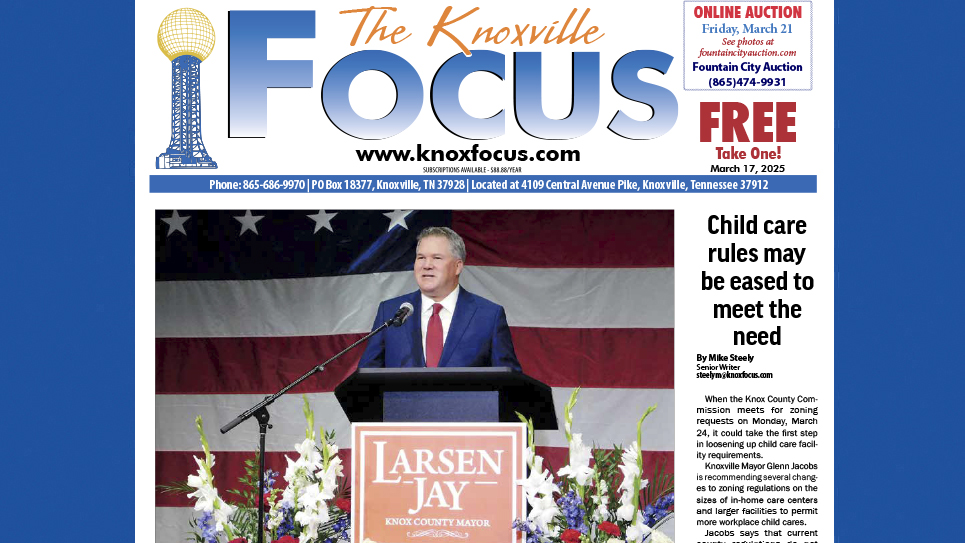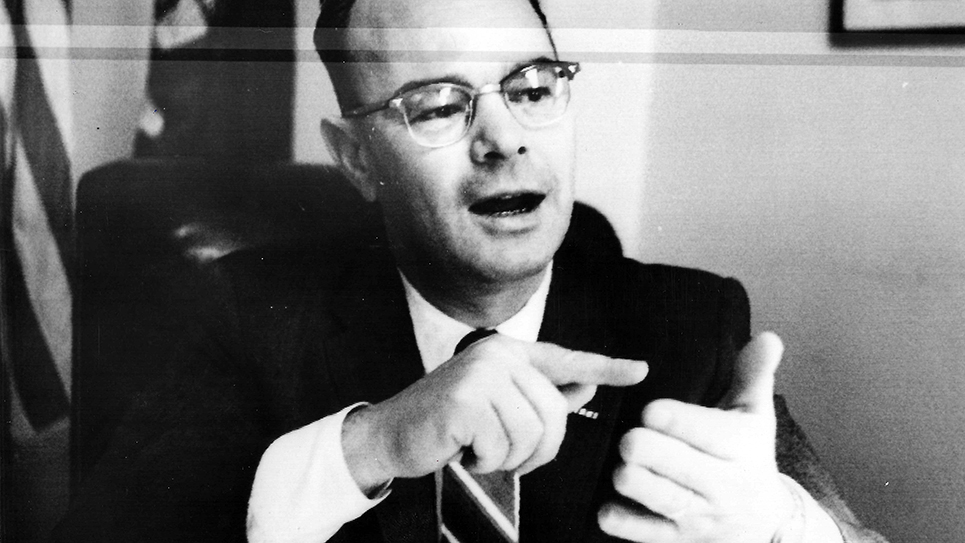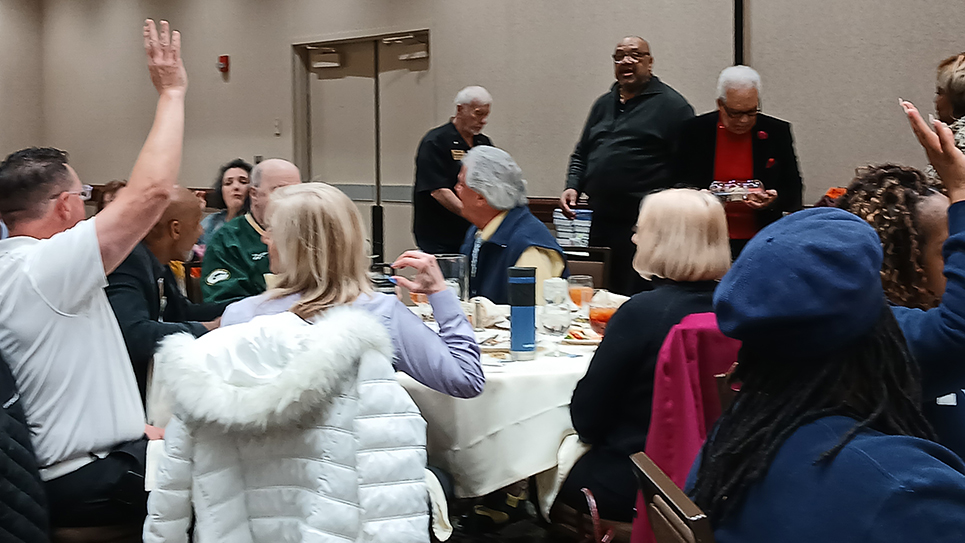By Ray Hill
Milton Ruben Young is a name very few of my readers are likely familiar with and he was an improbable member of the United States Senate. Even in his native state of North Dakota, Young is something of vague figure despite almost thirty-six years of service in the Senate. Indeed, Milton Young served in office continuously from 1924 until his retirement in 1981 in one political office or another.
A farmer, Young was certainly no powerful orator; in fact, quite the contrary, Milton Young had a terrible stutter. Nor was he highly educated as he only attended what was then North Dakota Agricultural College just long enough to play football for a season. Young attended another college very briefly, yet again to play football before ending his formal education. Thoroughly committed to his farm and farming, it was Young’s commitment – – – some called it his “obsession” – – – with agriculture that kept him in the U. S. Senate as one of the longest serving Republican senators in our country’s history. Young’s dedication to agriculture and farming suited a state that was largely agricultural when Milton Young first went to the Senate in 1945.
It was that same dedication to the agricultural interests of North Dakota that caused Young to be referred to as “Mr. Wheat” by newspapers in the Peace Garden State. Keep in mind, at the time, only one state in the country produced more wheat than North Dakota. More than a quarter of the people of North Dakota lived on farms or ranches.
Senator Young brought North Dakota her share of federal projects and monies. Young deliberately avoided the limelight. Asked about his political longevity, Milton Young replied, “I have always tried to stay close to the people. In North Dakota to be elected and to stay on, you have to know the farmers and stay close to them. They are loyal to a fault.”
Yet Milton R. Young could occasionally surprise for it was the North Dakota Republican who sponsored the legislation which caused Ford’s Theater, the site of President Abraham Lincoln’s assassination, to be restored. When he died, a reporter from the Washington Post remembered Young as “[a] tall, laconic man with a leathery face, he was the picture of dignity.” That same reporter noted Senator Young was “more of a listener than talker.” One staffer remembered Milton Young as “a tenacious fighter for what he believed in”, devoted to North Dakota and her people and was one of the few senators who faithfully attended committee hearings.
Milton Young’s seniority and attention to detail brought him power and influence inside the U. S. Senate where he was the ranking member of both the Agriculture & Forestry and Appropriations Committees.
All of Young’s grandparents were immigrants from Germany. Before arriving in the Senate, Milton Young had been elected to the North Dakota House of Representatives for a term in 1932 and had served in the State Senate. Both of North Dakota Senate seats were occupied by controversial political figures. Gerald P. Nye, unlike Milton Young, was a dynamic and much sought after speaker, who was also a fierce isolationist. With war clouds hovering, Senator Nye toured the country as one of the foremost orators on behalf of the America First committee. The junior senator from North Dakota was William “Wild Bill” Langer, a former governor (who had once been removed from office) yet a formidable campaigner. Nye and Langer hated one another, although both, reflecting the majority opinion of their state, were strong isolationists.
Perhaps the greatest difference between Gerald Nye and William Langer was the former had far more of a national profile and renown as an isolationist, which was something of an inconvenient position following the attack on Pearl Harbor by the Japanese Empire. By 1944, with the Allies winning the war, Senator Gerald Nye was in deep trouble at home. The fact Nye had divorced his wife to marry a pretty and younger woman certainly did not help him politically. Nye also faced a strong challenge inside the Republican primary from Lynn Stambaugh and Congressman Usher Burdick. Nye won his party’s nomination with a mere 33% of the vote, beating his nearest competitor, Lynn Stambaugh, by 972 votes. Stambaugh promptly announced he was launching a candidacy in the general election as an Independent, but the Democrats, which were a distinct minority in North Dakota at the time, had fielded their strongest candidate: John Moses. Moses had been elected governor in 1938 and reelected in 1940 and 1942. Moses campaigned all across the state, orating in English, Norwegian or German.
Rumors circulated during the 1944 general election campaign that Governor Moses was mortally ill with cancer. Moses had undergone surgery for an intestinal obstruction in September of 1944 at the Mayo Clinic and insisted he would be able to serve a six-year term in the U. S. Senate. Much of the Moses campaign was conducted by surrogates and run in absentia as the candidate remained at the Mayo Clinic through most of October. Claiming he was “cured”, the governor came home to North Dakota to begin a series of appearances for the last days of the fall campaign.
John Moses became the first Democrat to be elected to the United States Senate from North Dakota when he defeated Senator Gerald Nye and Independent Lynn Stambaugh, winning a plurality of the vote. Governor Moses won just over 45% of the ballots cast while Senator Nye was a distant second with 33%. Lynn Stambaugh trailed with little more than 21% of the vote. Nye’s strident isolationism, divorce and long tenure in office had caught up with him. Unfortunately, the rumors about John Moses’ illness were true. After taking office on January 3, 1945, he returned to the Mayo Clinic on January 18, fifteen days after he had been sworn into office. Senator John Moses died at 3 a.m. on March 3. It fell to Republican governor Fred Aandahl to appoint a successor to the late Senator Moses. Immediately there was speculation former senator Gerald Nye might be returned to the U. S. Senate. Instead, Governor Aandahl appointed state senator Milton R. Young who owned a 1,300 acre farm in Berlin, North Dakota. The Bismarck Tribune called Young’s appointment a sign that Governor Aandahl was “completely orthodox in his political thinking.” Milton Young was one of those who had stoutly supported Fred Aandahl for governor and was considered to be a member of the North Dakota chief executive’s “inner circle.” Young had run one statewide race previously, for a congressional seat in the 1944 GOP primary and had run behind an incumbent congressman and a former congressman for North Dakota’s two at-large seats. Although he lost, Milton Young had run a credible race.
The Bismarck Tribune commented in an editorial the newly appointed senator had made a favorable impression, writing, “The people as a whole are pleased with the forthright manner in which the senator-designate has declared his attitude on foreign affairs.” The Tribune was pleased Governor Aandahl had not appointed an isolationist to the Senate as a vote on whether the United States would participate in the United Nations would come that year. When that vote rolled around, only two members of the Senate voted against the United States joining the United Nations; Henrik Shipstead and William Langer. Both were Republicans and both remained isolationists. Shipstead would lose his primary in 1946 and believed until his dying day his vote against the UN was the cause of his defeat. “Wild Bill” Langer remained astonishingly popular in North Dakota and remained in office until his death in 1959, after having been reelected to yet another term in 1958.
Senator Young tended to his duties quietly in the Nation’s Capitol where he was overshadowed by his more colorful senior colleague Bill Langer. The first test of Young’s popularity came in the 1946 special election to serve the remaining four years of the late John Moses’ term. Governor Fred Aandahl took to the radio to support Senator Young’s candidacy for the Republican nomination. The governor described Young as a “liberal…seasoned with the good business judgment of a farmer.”
North Dakota Republicans met in a raucous convention and bickered over organization for an hour and finally nominated Senator Milton R. Young on the second ballot. Former senator Gerald Nye was bidding for the nomination and while he retained a following inside his party, he ran third behind Dr. George Schatz. The fiery Gerald Nye announced he would seek reelection to the Senate in the 1946 special election as an Independent candidate. Milton Young faced Nye and William Lanier, the Democratic candidate, on the November ballot. Young carried every county in North Dakota and won more than 55% of the vote. Gerald Nye won 15% after a serious campaign and the defeat ended his long political career.
Milton Young was never one of the Senate’s “show horses”, but rather a dedicated and admittedly colorless farmer tending to his duties and responsibilities as United States senator for a primarily rural and agricultural state. Young concentrated upon constituent service and agricultural issues. When Young came up for reelection in 1950, the senator was challenged inside the GOP primary by Lieutenant Governor T. H. Thoresen. Young crushed his opponent, winning more than 70% of the vote. Young proved to be almost as popular in the general election, winning quite nearly 68% of the ballots cast by North Dakotans.
Senator Young proved to be enduringly popular with the people he represented even after endorsing a Democrat for president in 1952. Young said Georgia U. S. senator Richard Russell was “superbly qualified” to serve as President of the United States, a sentiment shared by many who knew the Georgian. While Young’s comment caused something of a sensation at the time, but it did little to tarnish the senator’s standing with his fellow Republicans in North Dakota. Young was renominated in the 1956 GOP primary with almost 90% of the vote. Once again, Milton Young won the general election easily.
Milton Young was kindly, thoughtful and hardworking, qualities North Dakotans apparently liked and appreciated as they routinely reelected the senator throughout the decade of the 1960s.
One of the few people Milton Young apparently disliked was Mark Andrews, who had been the Republican nominee for governor in 1962. In 1963, North Dakota Congressman Hjalmar Nygaard walked into the office of Dr. George Calver, the physician to Congress, where he complained he was having chest pains. Congressman Nygaard promptly died of a heart in the office of Dr. Calver, necessitating a special election in North Dakota. That election was won by Mark Andrews. Evidently Senator Young felt like Andrews coveted his Senate seat, which generated some resentment and dislike on the part of the Senator. There were those who believed Young might have been tempted to retire in 1974 had it not been for the senator’s belief Mark Andrews would run to succeed him.
Seventy-seven years old in 1974, Milton Young surprised many people when he announced he would run yet again. Senator Young faced the most serious political threat of his career with the announcement of William L. Guy for the Senate. Guy had been governor of North Dakota from 1961 – 1973, serving two two-year terms and two four-year terms as the state’s chief executive. Guy was a Democrat and immensely popular with North Dakotans. A poll taken in the spring of 1974 showed the former governor leading Senator Young with 53% to 36%.
1974 was something of a nadir for the national Republican Party and its candidates due to the burgeoning scandal of the Watergate break-in and the subsequent resignation of President Richard Nixon. Democrats picked up four Senate seats that year and forty-nine in the House of Representatives. The race between Senator Milton Young and former governor William L. Guy was a campaign between two of the most consistently popular candidates in North Dakota’s history.






